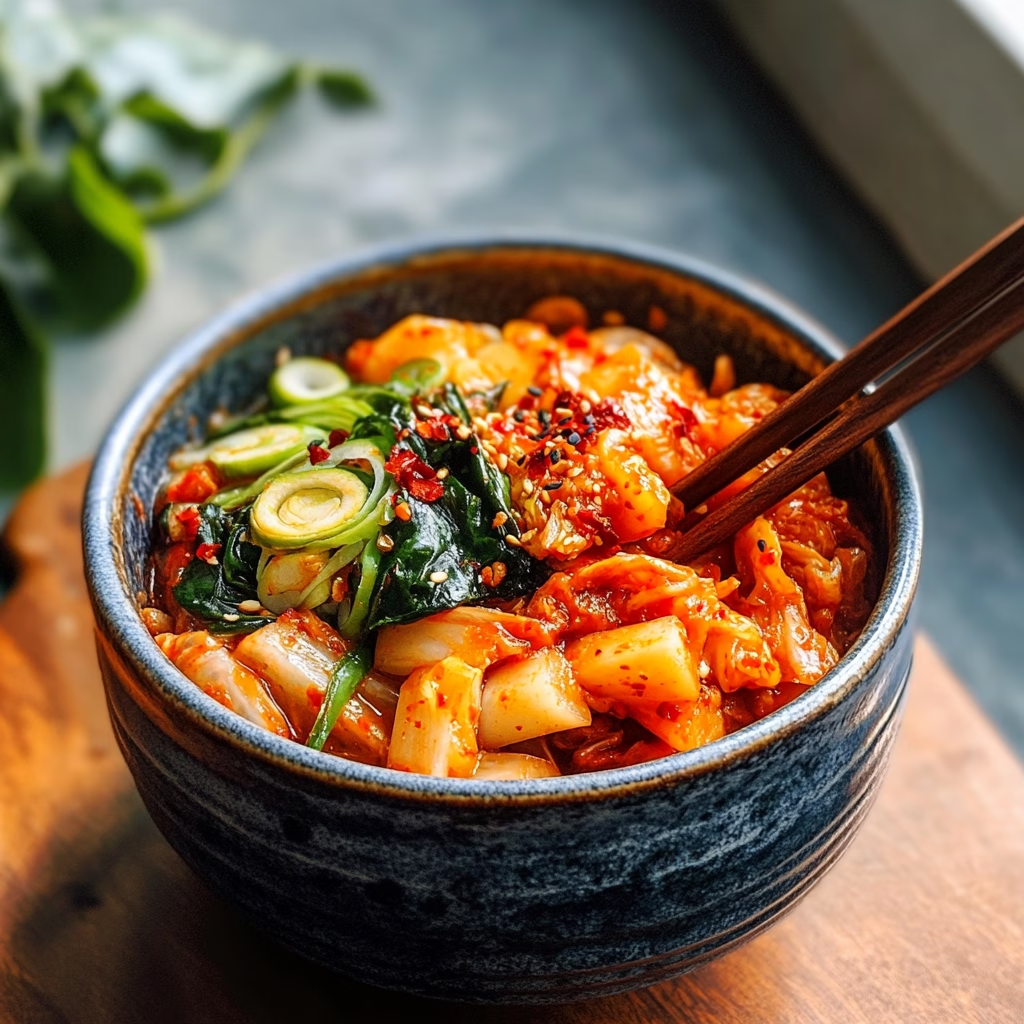Oh, let me tell you about one of my absolute favorite homemade delights: Vegan Kimchi! I first stumbled across this traditional Korean recipe during a culinary adventure with some friends, and let me tell you—the joy of crafting your own kimchi at home is unmatched. It’s such a fun process, and honestly, there’s something unbelievably satisfying about watching those vibrant veggies ferment into something uniquely delicious.
I remember the first batch I made nearly a decade ago. I was so excited that I forgot to wear gloves while mixing the spicy kimchi paste. Big mistake! As soon as I touched my face, I could feel the fiery heat of the gochugaru (Korean red pepper flakes) creeping up! But hey, that just added to the memorable experience. Over the years, I’ve perfected my method (and learned to always wear gloves!), and now I’m ready to share my tips and recipe with you, so you can make your own scrumptious vegan kimchi!
What’s in Homemade Vegan Kimchi?
Let’s break down the ingredients that make this dish so mouth-wateringly delicious:
Napa Cabbage: This is the star of the show! Its crunchy texture and mild flavor make it a perfect base for kimchi. I always choose the freshest cabbage I can find, and don’t be shy to pick one with nice, crisp leaves!
Sea Salt: Essential for drawing out moisture from the cabbage and creating that lovely brine. It helps with the fermentation process, too. I prefer using coarse sea salt for a balanced taste.
Radish: Julienned radish adds a delightful crunch and a peppery kick to the kimchi. Plus, it holds up well during fermentation, so you’ll always have a nice bite!
Green Onions: Fresh, vibrant green onions lighten the whole dish and pack in some great flavor—perfect for balancing out the spiciness.
Carrots: I love adding colorful carrots for sweetness and crunch. They also give the kimchi a lovely color!
Garlic: Minced garlic is a must-have for that pungent, aromatic flavor that makes kimchi irresistible.
Ginger: Freshly grated ginger brings a warm, zesty note that complements the garlic beautifully.
Sugar: Just a touch helps balance out the flavors and boosts fermentation. Don’t worry, it’s not a dessert!
Gochugaru: This is where the magic happens! These spicy Korean red pepper flakes give kimchi its signature heat and vibrant color. Look for the bright red flakes and avoid the powdery kind—trust me!
Soy Sauce or Tamari: This adds depth and umami to the paste. I often prefer tamari to keep it gluten-free.
Rice Vinegar: This adds a hint of acidity, which is crucial for a well-balanced kimchi.
Sesame Oil: (Optional) A splash of sesame oil gives a nutty flavor and richness, rounding out the taste. I can’t resist adding it!
Is Homemade Vegan Kimchi Good for You?
Absolutely! Homemade vegan kimchi is not only delicious but also packed with health benefits:
Napa Cabbage: This leafy green is full of vitamins A and C and is low in calories, making it a great addition to any diet. Plus, it’s a great source of fiber to keep you feeling full.
Probiotics: Thanks to fermentation, kimchi is loaded with probiotics which are excellent for gut health. It aids digestion and may help boost your immune system.
Antioxidants: With ingredients like garlic, ginger, and the vibrant gochugaru, you’re getting a powerful antioxidant boost that can combat inflammation and oxidative stress.
However, it’s worth noting that while kimchi is healthy, it can also be high in sodium due to the salt used in the fermentation process. So, if you’re watching your sodium intake, just enjoy it in moderation.
Homemade Vegan Kimchi Ingredients
– 1 medium Napa cabbage, chopped into quarters
– 1/4 cup sea salt
– 4 cups water (for soaking)
– 1 cup radish, julienned
– 4 green onions, chopped
– 1/2 cup carrots, julienned
– 5 cloves garlic, minced
– 1-inch piece ginger, grated
– 1 tablespoon sugar
– 1/4 cup gochugaru (Korean red pepper flakes)
– 1 tablespoon soy sauce (or tamari for gluten-free)
– 1 tablespoon rice vinegar
– 1 teaspoon sesame oil (optional)
This recipe yields about 4-6 servings, depending on how much kimchi you can devour in one sitting!
How to Make Homemade Vegan Kimchi?
1. **Prepare the Cabbage:** In a large bowl, dissolve the sea salt in the water. Add the Napa cabbage and let it soak for about 2 hours, turning occasionally, until it softens.
2. **Rinse and Drain:** After 2 hours, rinse the cabbage under cold water a few times to wash off excess salt. Drain it well and set aside.
3. **Combine Vegetables:** In a large mixing bowl, combine the rinsed cabbage, radish, green onions, and carrots.
4. **Make the Kimchi Paste:** In a small bowl, mix together minced garlic, grated ginger, sugar, gochugaru, soy sauce, rice vinegar, and sesame oil (if using) until you have a thick paste.
5. **Mix the Paste with Vegetables:** Put on some gloves (believe me, you don’t want that spice on your skin!) and add the paste to the vegetable mixture. Toss everything together until all the veggies are well-coated.
6. **Pack Into Jars:** Transfer the kimchi mixture into clean, airtight jars. Press the mixture down to remove air pockets, leaving some space at the top for fermentation.
7. **Ferment:** Seal the jars and allow them to ferment at room temperature for 1-5 days based on how strong you want the flavor to be. Check daily and press down if necessary.
8. **Store in Refrigerator:** Once it reaches your desired taste, transfer the jars to the fridge to slow down the fermentation process. The kimchi will continue to evolve in flavor over time.
Kimchi Tips & Tricks for Success!
– Make sure to use non-reactive containers for fermentation (glass jars work beautifully) to avoid any weird flavors leaching from metal or plastic.
– You can tweak the spice level to match your preference by adjusting the amount of gochugaru. Feel free to add sliced red chili peppers for extra heat!
– For a fun twist, add other veggies like cucumber or celery for a unique crunch.
– Serve it as a side dish, in soups, or even use it as a topper on tacos—get creative!
Whether you’re a kimchi newbie or a seasoned fermenter, I truly believe that there’s something special about making this beloved side dish at home. So give it a try! Let me know how yours turns out and feel free to share any of your own tips or variations. Happy fermenting!



